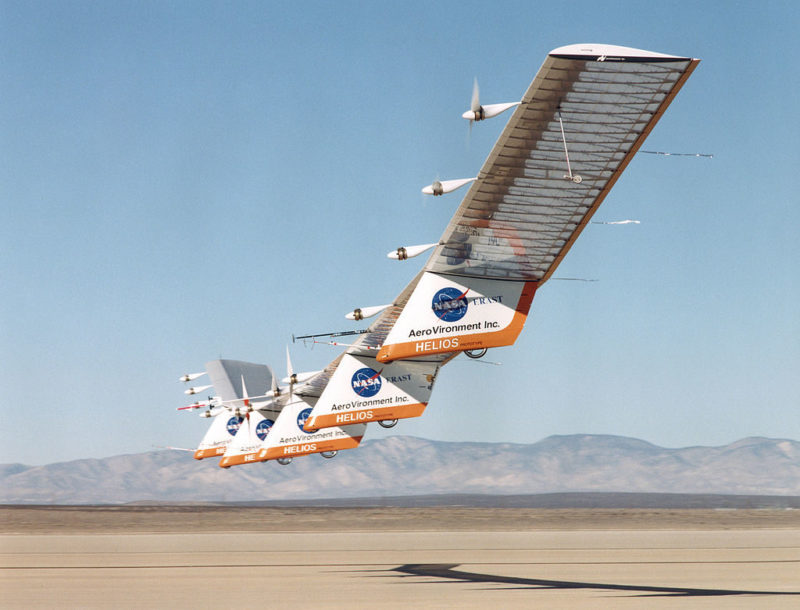SoftBank Backs New High Altitude Pseudo-Satellite Venture

AeroVironment’s Helios prototype. Photo: NASA/Tom Tschida.
A High Altitude Pseudo-Satellite (HAPS) is a category of unmanned aircraft that AeroVironment thinks could deliver a multitude of benefits to the commercial market through use of Internet of Things (IOT) and other technologies and concepts. The company has announced a joint venture with a Japanese firm to develop a solar-powered, high-altitude, long-endurance Unmanned Aircraft System (UAS) and certificate it.
Called HAPSMobile, the new joint venture would be 95 percent owned by Japan-based telecommunications operator SoftBank, AeroVironment said. It would own the remaining 5 percent, committing $5 million in capital with an option to increase its stake up to 19 percent. AeroVironment said HAPSMobile would fund the development program up to a net maximum value of some $65 million.
“For many years, we have fully understood the incredible value high-altitude, long-endurance unmanned aircraft platforms could deliver to countless organizations and millions of people around the world through remote sensing and last mile, next generation IOT connectivity,” said Wahid Nawabi, AeroVironment Chief Executive Officer (CEO). “We were searching for the right strategic partner to pursue this very large global opportunity with us. Now we believe we are extremely well-positioned to build on the decades of successful development we have performed to translate our solar UAS innovations into long-term value through HAPSMobile.”
AeroVironment said it would design and develop both the aircraft and ground control stations for flight testing and certification. Both parties in the joint venture agreed to license some background intellectual properties to HAPSMobile. AeroVironment would possess exclusive rights to the resulting intellectual property for certain non-commercial applications, except in Japan, as well as exclusive rights to design and manufacture all such aircraft in the future for HAPSMobile (subject to the terms of the agreement). HAPSMobile would own the drone intellectual property and have exclusive rights for commercial applications globally, and non-commercial applications in Japan.
Not a stranger to the concept of high-altitude and solar-powered UAS, AeroVironment claims to have “pioneered” the concept in the 1980s. It developed and demonstrated multiple systems for NASA’s Environmental Research Aircraft and Sensor Technology program during the following two decades.
In 2001, a prototype reached an altitude of 96,863 feet, which AeroVironment said set a world record for sustained horizontal flight by a singed aircraft. The following year, the company said another prototype performed the “world’s first” UAS telecommunications demonstrations at 65,000 feet. It was able to provide High-Definition Television (HDTV) signals, 3G mobile voice, video and data and high-speed internet connectivity.
From 2007 to 2011, multiple U.S. government agencies funded the development of the hybrid-electric Global Observer drone, the company said. The aircraft was a concept for a solution for extended operation over high Northern and Southern latitudes during local winters, when the sun’s energy is insufficient to maintain continuous solar aircraft operation at high altitude, AeroVironment said.
“For many years, we have fully understood the incredible value high-altitude, long-endurance unmanned aircraft platforms could deliver to countless organizations and millions of people around the world through remote sensing and last mile, next generation IoT connectivity,” said Wahid Nawabi, AeroVironment CEO. “We were searching for the right strategic partner to pursue this very large global opportunity with us. Now we believe we are extremely well-positioned to build on the decades of successful development we have performed to translate our solar UAS innovations into long-term value through HAPSMobile Inc.”
AeroVironment said it would design and develop both the aircraft and ground control stations for flight testing and certification. Both parties in the joint venture agreed to license some background intellectual properties to HAPSMobile. AeroVironment would possess exclusive rights to the resulting intellectual property for certain non-commercial applications, except in Japan, as well as exclusive rights to design and manufacture all such aircraft in the future for HAPSMobile (subject to the terms of the agreement). HAPSMobile would own the drone intellectual property and have exclusive rights for commercial applications globally, and non-commercial applications in Japan.
Not a stranger to the concept of high-altitude and solar-powered UAS, AeroVironment claims to have “pioneered” the concept in the 1980s. It developed and demonstrated multiple systems for NASA’s Environmental Research Aircraft and Sensor Technology program during the following two decades.
In 2001, a prototype reached an altitude of 96,863 feet, which AeroVironment said set a world record for sustained horizontal flight by a singed aircraft. The following year, the company said another prototype performed the “world’s first” UAS telecommunications demonstrations at 65,000 feet. It was able to provide high-definition television (HDTV) signals, third-generation (3G) mobile voice, video and data and high-speed internet connectivity.
From 2007 to 2011, multiple U.S. government agencies funded the development of the hybrid-electric Global Observer drone, the company said. The aircraft was a concept for a solution for extended operation over high Northern and Southern latitudes during local winters, when the sun’s energy is insufficient to maintain continuous solar aircraft operation at high altitude, AeroVironment said.
This story was originally published in Avionics, a Via Satellite sister publication. It has been edited to better serve our audience.